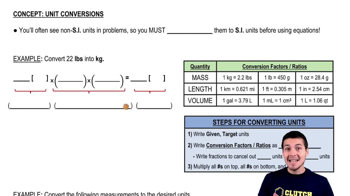Here are the essential concepts you must grasp in order to answer the question correctly.
SI Units
The International System of Units (SI) is a standardized system of measurement used globally in science and engineering. It is based on seven base units, including the meter for length, kilogram for mass, and second for time. Understanding SI units is essential for converting measurements from other systems, such as the imperial system, to ensure consistency and accuracy in calculations.
Recommended video:
Introduction to Units & the SI System
Unit Conversion
Unit conversion is the process of converting a quantity expressed in one set of units to another set of units. This involves using conversion factors, which are ratios that express how many of one unit are equivalent to another. For example, to convert feet to meters, one can use the conversion factor that 1 foot is approximately 0.3048 meters. Mastery of unit conversion is crucial for solving problems in physics and engineering.
Recommended video:
Velocity
Velocity is a vector quantity that refers to the rate of change of an object's position with respect to time. It is typically expressed in units of distance per time, such as meters per second (m/s) in SI units. In the given question, converting 62 feet per day to SI units involves recognizing that this represents a velocity, which can be expressed in meters per second for consistency with other measurements in physics.
Recommended video:
 Verified step by step guidance
Verified step by step guidance


